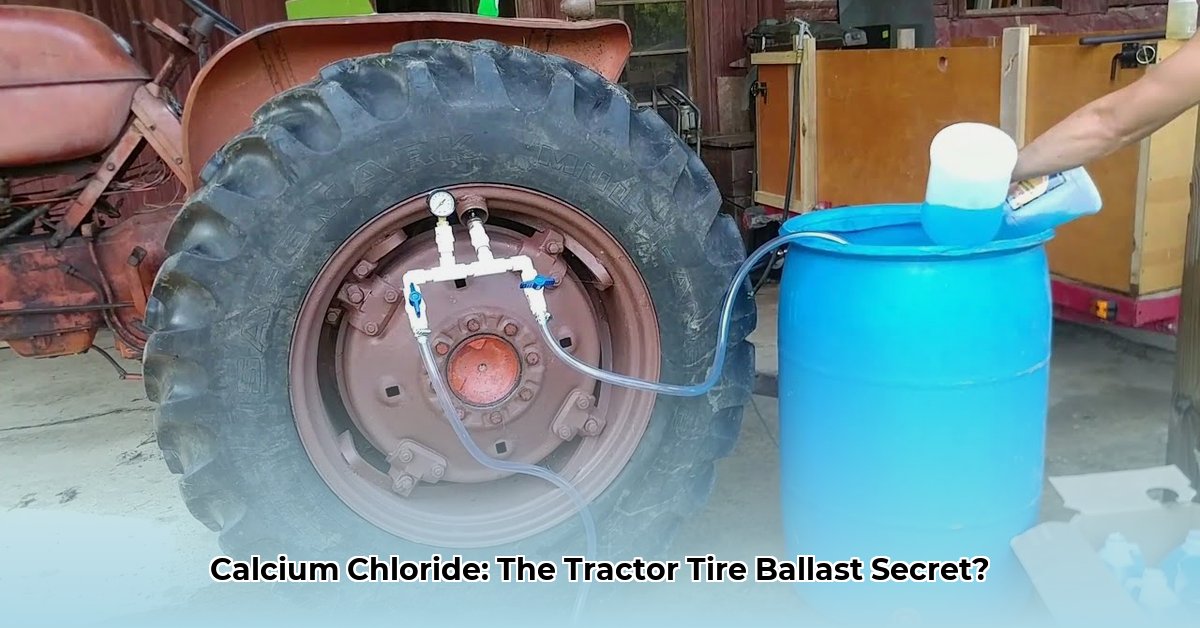
Choosing the right ballast for your tractor tires significantly impacts performance, longevity, and operational costs. While calcium chloride offers a budget-friendly option, understanding its limitations and comparing it to alternatives is crucial for making an informed decision. This guide will help you navigate the choices and select the best ballast for your specific needs. For more in-depth information, check out this comprehensive guide.
Why Ballast Your Tractor Tires?
Adding ballast to your tractor tires enhances several key aspects of operation:
- Improved Traction: Greater weight provides superior grip, especially in challenging conditions like muddy fields or hilly terrain. This translates to safer and more efficient operation.
- Enhanced Stability: Increased weight lowers the center of gravity, significantly reducing the risk of rollovers, a major safety concern for farmers.
- Smoother Operation: Better traction and stability lead to a smoother ride, which reduces stress on both the equipment and the operator.
- Potential Fuel Efficiency Gains: With better traction, your tractor doesn't have to work as hard, potentially leading to some fuel savings.
Proper ballasting enhances both safety and efficiency on the farm.
Calcium Chloride: A Cost-Effective but Corrosive Option
Calcium chloride's popularity stems from its low upfront cost and widespread availability. It effectively adds significant weight to your tires, improving traction and stability. However, its corrosive nature poses serious long-term consequences.
Pros:
- Low Initial Cost: Significantly cheaper than other ballast options.
- Readily Available: Easily sourced from most agricultural supply stores.
- Effective Weight Addition: Substantially increases tire weight for improved performance.
Cons:
- High Corrosion Risk: Calcium chloride aggressively corrodes rims and tire components, leading to costly repairs or premature tire failure. This is a major concern impacting long-term operational expenses.
- Moisture Absorption: Attracts moisture, potentially accelerating corrosion and rust within the tires and wheels. This problem increases with high humidity.
- Environmental Considerations: Improper disposal can lead to environmental damage. Adhere strictly to local regulations for disposal.
Alternatives to Calcium Chloride: A Comparative Analysis
While calcium chloride's low cost is tempting, exploring alternatives minimizes long-term risks and environmental impact. Consider these options:
- Water: The cheapest option, but only suitable for warm climates as it freezes in cold temperatures, potentially damaging tires. It also offers the least amount of added weight per volume.
- Beet Juice: Environmentally friendly and less corrosive than calcium chloride. However, availability depends on local beet processing facilities, and it can ferment. It is also relatively expensive.
- Propylene Glycol (PG): A superior antifreeze option, less toxic and less corrosive than other alternatives. However, it's significantly more expensive than calcium chloride, and careful handling is necessary.
Making the Right Choice: Factors to Consider
Selecting the optimal ballast requires careful consideration of multiple factors:
- Climate: Water is unsuitable in freezing temperatures. PG excels in cold weather. Calcium chloride's effectiveness diminishes with temperatures close to freezing.
- Budget: Calcium chloride offers the lowest initial investment, but long-term corrosion repairs can negate cost savings.
- Environmental Impact: Beet juice is the most environmentally friendly choice, but its availability and cost should be weighed.
The following table summarizes the key characteristics of each ballast type:
| Ballast Type | Initial Cost | Corrosion Risk | Freeze Resistance | Environmental Impact | Long-Term Cost |
|---|---|---|---|---|---|
| Water | Very Low | Low | Very Low | Low | Potentially High |
| Calcium Chloride | Low | High | Moderate | Moderate | Potentially High |
| Beet Juice | Moderate | Low | Moderate | Low | Moderate |
| Propylene Glycol (PG) | High | Low | High | Moderate | Moderate to Low |
Best Practices for Using Calcium Chloride (If Selected)
If opting for calcium chloride, follow these crucial steps:
- Thorough Rim Cleaning: Meticulously clean rims to remove rust, dirt, and debris before filling. This minimizes corrosion.
- Regular Inspections: Check for leaks and corrosion regularly. Early detection prevents major damage.
- Responsible Disposal: Dispose of used calcium chloride responsibly according to local regulations.
Conclusion: Balancing Cost, Performance, and Sustainability
The ideal ballast for your tractor tires is dependent on your individual circumstances. By carefully considering your climate, budget, environmental concerns, and the long-term costs associated with each option, you can make an informed decision that optimizes both performance and sustainability. Remember that ongoing research continues to explore new, more sustainable ballasting alternatives. Staying informed about industry advancements is always advisable.